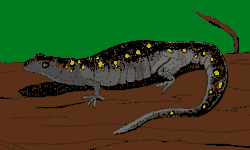|
|
|
|
|
|
Species Spotlight
on

Ambystoma maculatum
| A.K.A.: | The Spotted Salamander |
| DESCRIPTION: | Dark black, gray, or brown with yellow and / or orange spots. Robust body. 12 grooves on it's sides. Grey to purple-brown belly |
| SIZE: | 5" to 9.75" |
| HOME: | Eastern North America: From Nova Scotia to Texas |
| HABITAT: | Moist deciduous woods and hillsides near ponds. They avoid areas that are prone to flooding. |
| LIFESTYLE: | Spends most of the time underground. They hunt from the mouths of their tunnels at night. They migrate to ponds for breeding. |
| FOOD: | Salamanders: Worms, insects, crickets, and locusts. Larvae: small aquatic invertebrates. |
| DEFENSES: | Salamanders will lash out their tails at attackers. They will also secrete a noxious substance from glands found near the base of their tail and behind their eyes. |
| BREEDING: | Takes place between January and April depending on location. In colder climates, breeding occurs later than in warmer climates. The females will lay one egg mass that will contain 50 to 250 eggs. the egg masses are usually attached to underwater plants or debris. Egg masses may turn green if algae is present. It is thought that the algae is beneficial to the eggs in providing them with additional oxygen. Eggs will hatch after one or two months. Metamorphosis takes place in two to four months after hatching. On occasion, larvae may not metamorphoses until the following spring. |
| LIFE SPAN: | 20 years. Sexual maturity is reached at 2 years. |
| SPECIAL CONCERNS: | In the wild, acid rain has polluted ponds containing the eggs. These polluted eggs can not develop. Many ponds in the northeastern part of this salamander's range have lost entire populations due to acid rain. In captivity, this species is prone to skin diseases. Many of these diseases may be avoided if animals have access to outdoor ponds. |